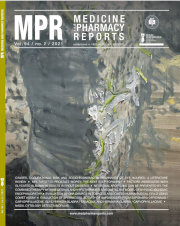Factors associated with glycated albumin in adults without diabetes
DOI:
https://doi.org/10.15386/mpr-1743Keywords:
glycated albumin, glycated hemoglobin, diabetesAbstract
Background and aims. Glycated albumin is a glycemic marker useful in short-term monitoring and in situations when a glycated hemoglobin test is not reliable. This study aims to evaluate glycated albumin levels and its associated factors in normoglycemic adults from Southern Brazil.
Method. 136 individuals, without diabetes or pre-diabetes, were included in this cross-sectional study. Levels of glycated albumin, glycated hemoglobin, and other biochemical markers were measured.
Results. Glycated albumin levels ranged from 11.1% to 17.5% (2.5th and 97.5th percentiles). Glycated albumin/glycated hemoglobin ratio was 2.8 ± 0.2. Glycated albumin did not differ according to gender and age groups. However, in overweight individuals, levels of glycated albumin and glycated albumin/glycated hemoglobin ratio were lower and weakly and negatively correlated with body mass index.
Conclusions. Glycated albumin levels in Brazilians were similar to those previously described in other populations. Glycated albumin seems to be irrespective of gender or age, but weakly correlated with weight. These aspects should be taken into account in the interpretation of glycated albumin results.
Downloads
Published
How to Cite
Issue
Section
License
The authors are required to transfer the copyright of the published paper to the journal. This is done by agreeing to sign the Copyright Assignment Form. Whenever the case, authors are also required to send permissions to reproduce material (such as illustrations) from the copyright holder.

The papers published in the journal are licensed under a Creative Commons Attribution-NonCommercial-NoDerivatives 4.0 International License.

